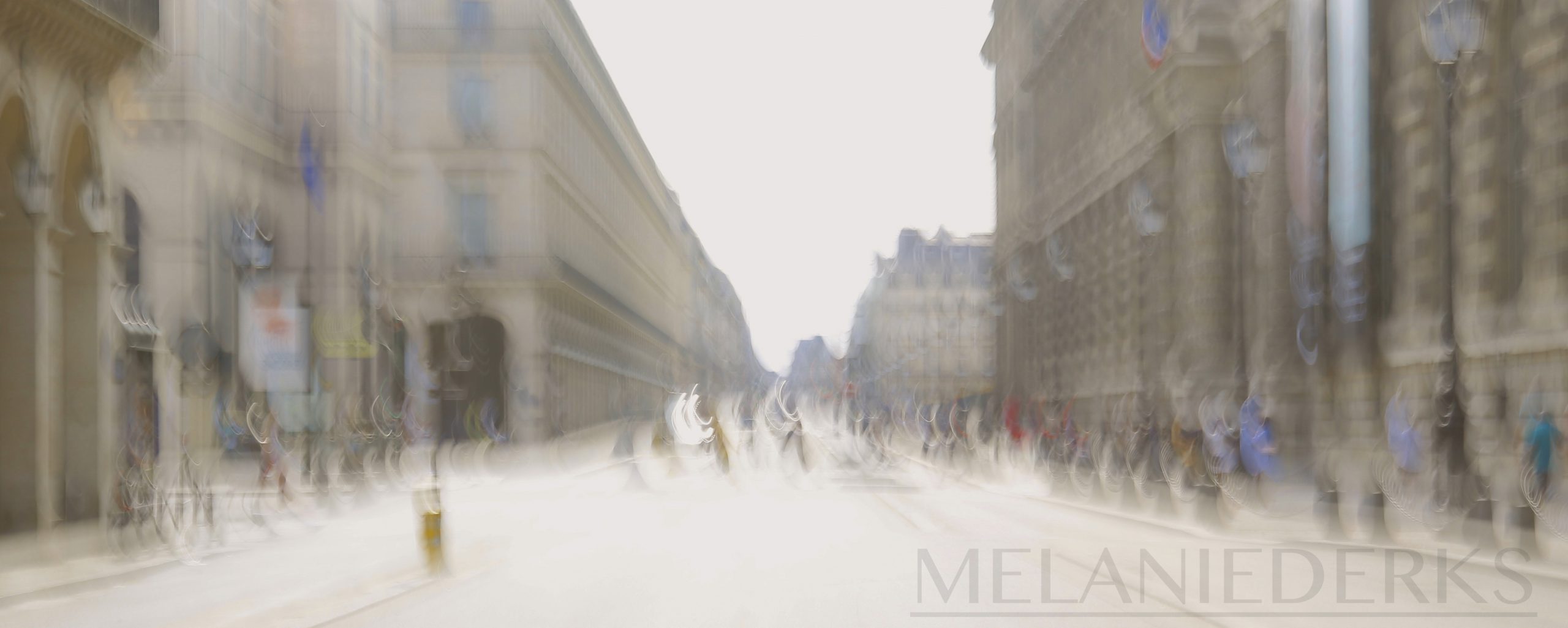
“My Pictures are a movement and a rest” (ENGLISH BELOW)
Het fotografisch werk van Melanie Derks wordt gekenmerkt door een voortdurend spelen met tijd en beweging dat nu eens impressionistisch, dan weer abstraherend uitpakt. Door gebruik te maken van lange sluitertijden en haar camera tijdens de opname te bewegen stuurt zij bewust aan op een bewogen en soms raadselachtig beeld van de werkelijkheid, waarin lijnen, vormen en kleuren vervormen en vervagen. De opnamen doen soms denken aan haastig geschoten snapshots en soms ook aan de schilderijen van de Franse impressionisten of zelfs aan abstracte kunstwerken. Melanie is zowel in het impressionistische als het abstracte beeld geïnteresseerd, maar het omslagpunt tussen die twee interesseert haar het meest. De tijd opgevat als een oneindige reeks momenten wordt net als in de film door haar op een schijnbaar willekeurig moment ruw stilgezet. Maar schijn bedriegt. Want altijd is haar focus gericht op het bijzondere van juist dat ene tijd- en plaatsgebonden unieke moment. Met deze werkwijze benadrukt zij niet alleen de bijzonderheid, maar ook de vluchtigheid en de eenmaligheid van elk moment en elke ervaring.
Aanvankelijk koos Melanie voor de technische kant van de fotografie en streefde zij naar technische perfectie, naar het verkennen en uitbuiten van alle mogelijkheden die de moderne camera biedt, wat resulteerde in steeds perfectere mooie plaatjes. De reacties waren lovend, maar uiteindelijk bleek deze ingeslagen weg niet te bevredigen. De uitdaging van het perfectioneren en professionaliseren van een ambacht, was voor haar niet voldoende. Ze miste het verrassingselement en de magie van het spelen met licht zoals in de begindagen van de fotografie. Ze vond dat terug in een nieuwe vorm: “photographic painting”. Het is een soort schilderen met de camera, zegt zij er zelf over, waarbij de camera afhankelijk van de instelling het penseel, de kwast of het plamuurmes is.
Geboren in de stad Amsterdam, verhuisde zij op 8-jarige leeftijd naar het landelijker gelegen Hilversum met veel groen en natuur. Daar ontwikkelde ze al snel de liefde voor de natuur, al bleef bij gelegenheid het drukke stadsleven een belangrijk uitdagend motief in haar werk. Een bijzondere interesse en passie ontwikkelde zij later voor kerken, zowel voor de gebouwen als voor het interieur met de gebrandschilderde ramen en kroonluchters.
(Recensie Emile Koelink, kunstverzamelaar en criticus)
***
Melanie Derks’ photographic work is characterised by a constant play with time and movement that sometimes turns out to be impressionistic, sometimes abstract. By using slow shutter speeds and moving her camera during the shot, she consciously steers towards a blurred and sometimes mystifying image of reality, in which lines, shapes and colors distort and blur. The images are sometimes reminiscent of hastily shot snapshots and sometimes also of the paintings of the French Impressionists or even of abstract works of art. Melanie is interested in both the impressionist and the abstract image, but the tipping point between the two interests her the most. Time conceived as an infinite series of moments is roughly stopped by her at a seemingly random moment, just like in the film. But appearances are deceiving. Because her focus is always on the specialness of that one time- and place-specific unique moment. With this working method she emphasizes not only the particularity, but also the volatility and the one-offness of every moment and every experience.
Initially, Melanie chose the technical side of photography and strived for technical perfection, for exploring and exploiting all the possibilities offered by the modern camera, resulting in increasingly perfect beautiful pictures. The reactions were laudatory, but in the end this path she took proved unsatisfactory. The challenge of perfecting and professionalizing a craft was not enough for her. She missed the element of surprise and the magic of playing with light as in the early days of photography. She found this in a new form: “photographic painting”. It is a kind of painting with the camera, she says, where the camera is the pencil, the brush or the putty knife depending on the setting.
Born in the city of Amsterdam, she moved at the age of 8 to the more rural Hilversum with its many green areas and nature. There she quickly developed a love of nature, although on occasion the busy city life remained an important challenging motif in her work. Later she developed a special interest and passion for churches, both for the buildings and the interior with its stained glass windows and chandeliers.
(Review Emile Koelink, art collector and critic)